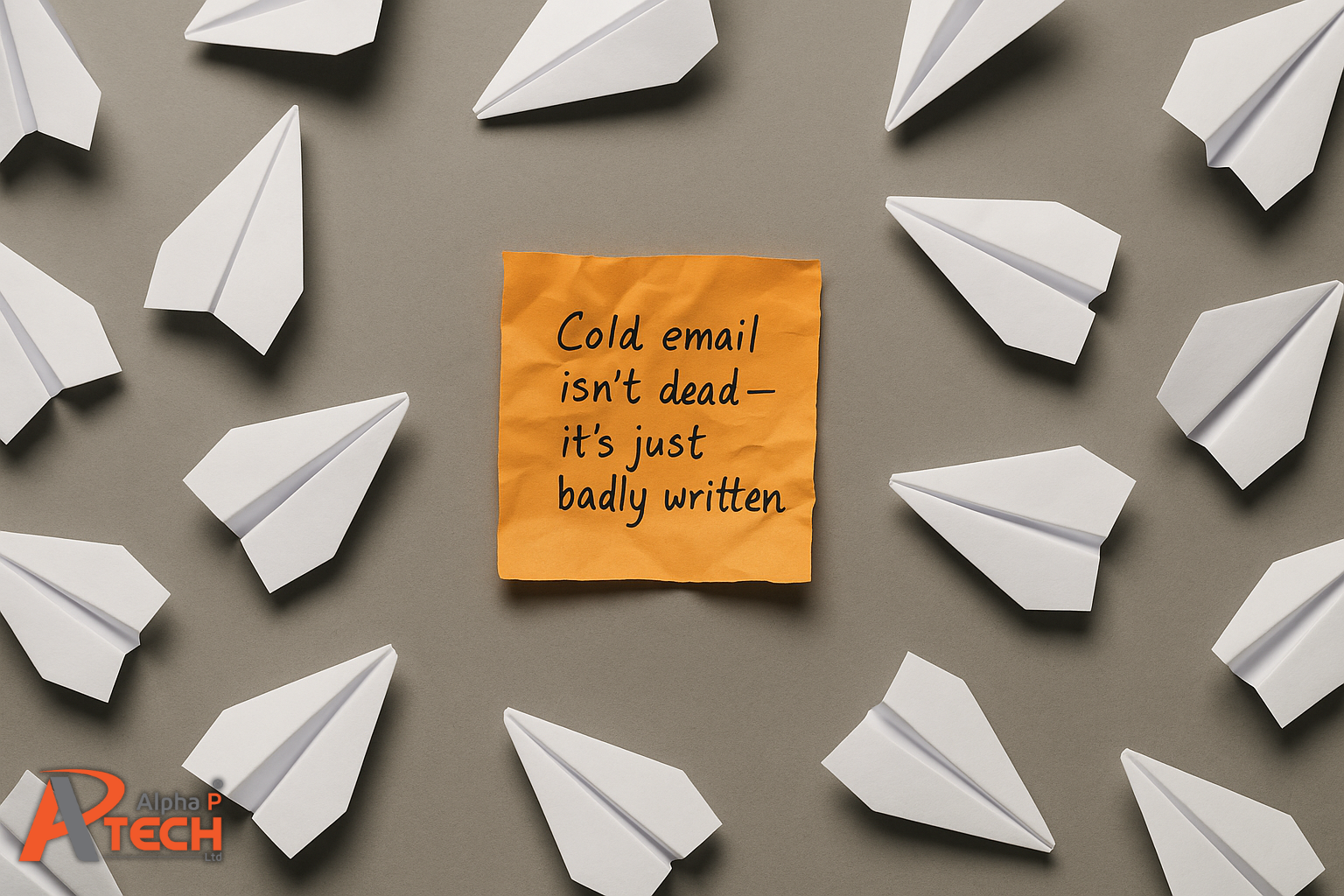Why Cold Email Has a Bad Name
“Cold email doesn’t work.” If you’ve spent any time in B2B marketing or sales, you’ve likely heard or even said those words. And honestly, it’s easy to see why. Inboxes are flooded with shallow pitches, recycled templates, and messages that reek of automation rather than intention.
But here’s the truth: the channel isn’t broken — the execution is. Most B2B email outreach falls flat not because cold outreach strategy is outdated, but because the cold email copywriting behind it lacks relevance, clarity, or basic respect for the reader’s time.
This article isn’t another rant. It’s a hands-on guide to what makes cold outreach actually work. We’ll unpack the anatomy of a strong cold email, from subject lines and openers to tone and CTAs, and share cold email tips, frameworks, and sales email best practices that help you start real conversations with decision-makers. Whether you’re refining your B2B email marketing or trying to improve reply rates, it starts with writing better emails. Let’s dive in.
The Real Problem: Shallow Offers and Even Shallower Copy
So why do most cold emails crash and burn? It’s rarely about sending too many. It’s that they read like they were written for everyone and no one at the same time. The real culprit behind poor B2B email outreach isn’t the cold outreach strategy itself but the lack of thought behind the message. Lazy cold email copywriting is everywhere: generic intros like “I hope this finds you well,” self-centred openings (“I’m reaching out because I wanted to introduce myself…”), and uninspired CTAs asking for yet another “quick call.” These aren’t just copywriting sins; they’re signals that the sender hasn’t done their homework.
If you’re in the B2B world at a manager or director level, then you’re tired of this. You’ve seen hundreds of these land in your inbox, often from people who haven’t bothered to understand your business, your priorities, or even your name. Here’s a typical example:
Subject: Following up
Hi Joshua,
I came across your profile and thought it made sense to connect. I’d love to schedule a quick call to tell you more about what we do. Would Tuesday or Thursday work for a chat?
It’s vague, offers no clear value, and puts the burden on the reader. This is exactly the kind of approach that gives cold email a bad name, and the kind we’ll help you avoid with smarter cold email tips, clearer messaging, and proven sales email best practices that actually respect your prospect’s time.
What a Great Cold Email Actually Looks Like
The goal of any great cold email isn’t to close a deal; it’s to earn attention. In B2B email marketing, attention is the hardest thing to win and the easiest thing to waste. Most cold outreach strategies fail not because the channel is broken, but because the copy is either irrelevant, unclear, or simply forgettable. Great cold email copywriting shifts the focus away from selling and towards sparking curiosity. It’s about starting a conversation, not finishing one.
So, what does that look like in practice? A well-crafted cold email typically includes five essential elements:
- Subject Line: Short, specific, and non-salesy. Think “Quick idea on [relevant topic]”, not “Let’s connect” or “Can I steal 15 mins?”
- Opener: Personal and relevant. Show that you’ve done your research and this isn’t part of a mass-send.
- Value Hook: Explain why you’re reaching out and what’s in it for them.
- CTA: Low-friction, respectful, and easy to say yes to. Ideally something they can respond to without booking a call.
- Tone: Clear, human, and respectful of their time.
Here’s an example of what that might look like when applied properly:
Subject: Quick idea on improving outbound replies
Hi Joshua,
I saw your recent LinkedIn post about scaling outbound without overloading your team — really sharp insight.
Having worked on the messaging for many B2B firms, I know it’s a common challenge for directors. Scaling without sacrificing relevance or personalisation is easier said than done.
If you’re currently exploring ways to strengthen your outbound strategy, I’d be happy to share a few approaches that have helped others improve response rates without adding more tools or headcount.
No pressure at all. Just let me know if that would be useful.
Best regards
✅ Why it works:
- The subject line teases relevance without hype.
- The opener proves the email is tailored to the recipient.
- It introduces the sender naturally, not forcefully.
- The value hook connects to a specific challenge.
- The CTA is light-touch, respectful, and offers value with no obligation.
When B2B email outreach is done this way, it stops feeling like noise and starts feeling like the start of something useful.
Subject Lines: First Impressions Matter
If your subject line doesn’t get the email opened, nothing else inside it really matters. In B2B email marketing, the subject line is your first chance to stand out and often your only one. It needs to spark curiosity while giving just enough context to feel relevant. This is where many cold outreach strategies fall short. Instead of being clear and specific, they rely on vague lines or cheap tricks that do more harm than good.
Tactics like using “Re:” to fake a reply or writing “Quick question” to feign urgency may have worked years ago, but today they tend to backfire. Senior decision-makers are used to spotting these tactics and will often delete the email without reading further.
A better approach is to write subject lines that speak to a real interest, challenge, or curiosity point your reader might have. It’s one of the simplest but most overlooked cold email tips: write like you’re trying to earn a conversation, not trick someone into one. When it comes to sales email best practices, honesty, clarity, and relevance are far more effective than cleverness.
Openers and Hooks That Show You’ve Done Your Homework
The first line of your cold email sets the tone, and it’s where many B2B email outreach efforts fall apart. If your opener feels vague, templated, or self-interested, you’ve already lost your reader. One of the most effective cold email tips is to start with something relevant. Show the person you’ve done your homework and that this isn’t just another spray-and-pray message.
Rather than using flattery or filler, focus on alignment. Mention a recent company announcement, a LinkedIn post, or a timely shift in their market. It signals care and context, two things automated emails can’t fake. For instance:
“Noticed you’re expanding into the UK and thought this might help your GTM strategy.”
or
“Saw from your press release you’ve launched a new advisory service — wondering how that’s shaping your current outreach efforts.”
These kinds of openers ground your message in the recipient’s world. In cold email copywriting, that’s how you earn trust early. It’s a foundational part of any thoughtful cold outreach strategy and a hallmark of sales email best practices. If you’d like to learn more about personalising emails, check out our guide, “The Power of Personalisation: Redefining B2B Marketing for Lasting Success”.
The CTA: Stop Asking for 15 Minutes
One of the fastest ways to lose your reader in a cold email is with a weak or overly demanding call to action. Many B2B email outreach messages end with vague requests like “Can we hop on a quick call?” but there’s nothing quick about handing over 15 minutes to a stranger. In today’s B2B email marketing landscape, time is currency, and decision-makers guard it closely.
The most effective cold outreach strategies replace vague CTAs with clear, useful offers. Instead of pushing for a meeting, offer something valuable upfront. Share a relevant insight, suggest a quick resource, or simply ask if your idea is worth exploring. For example:
“Would it make sense to share 2–3 ideas we used to help [similar firm] with [specific challenge]?”
or
“Happy to send over a short breakdown – only if it’s something on your radar.”
Instead of pushing for a meeting, offer something valuable upfront, a quick insight, a relevant resource, or a framework that helps them move one step further in their buying journey. This guide on B2B sales funnel optimisation offers more on how to structure those steps for higher conversion without adding pressure. It’s a simple shift that aligns with modern sales email best practices and shows that you respect the recipient’s priorities.
Tone and Timing: Write Like a Human, Not a Sales Robot
Tone and timing can make or break your cold outreach strategy. Before hitting send, do a simple check: would you reply to this if it landed in your inbox? If it sounds like it was written by a bot (full of buzzwords, fake urgency, or stiff corporate language) it’s likely to be ignored. The best cold email copywriting feels human. It’s clear, conversational, and grounded in the real world, not sales scripts.
Follow-ups are another area where many B2B email marketing efforts go off course. From my experience, sending three emails in a single week is too much. It quickly shifts from persistence to pressure. A better approach is to follow up two, at most three times, with each message spaced about a week apart. And don’t just resend the same thing. Every follow-up should offer something new, an extra idea, a relevant article, or a refined version of your initial offer.
This quality-over-quantity mindset is one of the most underrated cold email tips. It helps you move away from chasing metrics and towards starting meaningful conversations — the heart of all successful B2B email outreach.
Final Thoughts: Cold Email Works — If You Respect the Reader
Cold email isn’t dead — but bad writing might be killing your results. As we’ve explored, the problem with most B2B email outreach isn’t the channel itself, but how it’s used. It’s not about sending more messages. It’s about sending better ones. A thoughtful cold outreach strategy built on relevance, clarity, and respect will always outperform brute-force tactics.
If there’s one takeaway from these cold email tips, it’s this: treat your reader like a real person with limited time and real priorities. Good cold email copywriting doesn’t demand attention — it earns it. Test one of the frameworks from this article and see how a shift in tone, structure, or CTA can change the outcome.
If you’re tired of sending cold emails that go nowhere, let’s talk. We help founders and consultants write outreach that actually gets replies.



